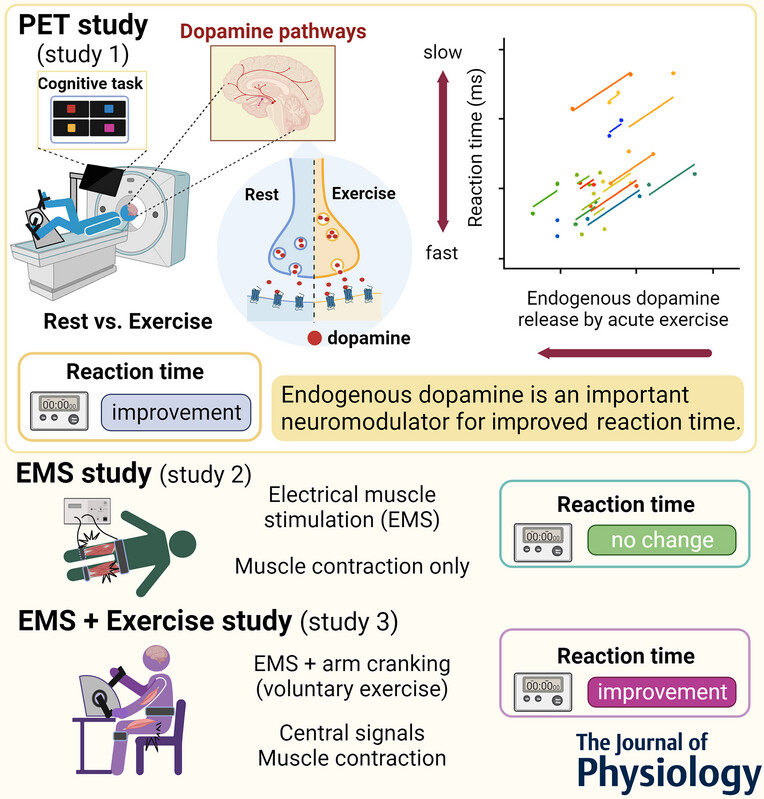The neuromodulatory role of dopamine in improving reaction time through acute cardiovascular exercise
Key points
|

Comments
People often feel more alert and smarter after a great workout, and dopamine could be the reason.
A small new study by British and Japanese researchers found that men released higher levels of the brain neurotransmitter during exercise. In turn, that seemed to be related to better performance on thinking tests, the researchers said.
"These latest findings support our previous theory that cognitive performance during exercise is affected by changes in brain regulatory hormones, including dopamine," said study co-author Dr. Joe Costell of the School of Science. Sport, Health and Exercise at the University of Portsmouth, England.
The findings were recently published in The Journal of Physiology .
In the study, Costello and his colleagues’ team had 52 men participate in three separate experiments. During the experiments, everyone’s brain activity was monitored with sophisticated PET imaging.
- In one test, men were asked to work on mentally challenging tasks while riding a bicycle lying down.
- In the second experiment, the men completed the same tasks, but this time they received "electrical muscle stimulation ," instead of training.
- The third experiment had them complete mental tasks while exercising and receiving electrical muscle stimulation.
Based on PET scan data, Costello’s group found an increase in dopamine release in the brain while the men were actively exercising, known as "voluntary" exercise .
This increase in dopamine was related to improvements in performing mental tasks.
No such effect was seen when the muscles were simply stimulated electrically, known as "involuntary" exercise .
"We wanted to eliminate voluntary muscle movement during part of the study, to see if the process in which acute exercise improves cognitive performance is present during manufactured exercise ," explained the study’s lead author, Soichi Ando, in a statement. of Portsmouth University Press.
"Our results indicate that exercise should be performed from central signals from the brain, and not just from the muscle itself," Ando said. He is an associate professor at the Laboratory of Health and Sports Sciences, Japan Electrocommunications University.
"This suggests that when we tell our central command to move our body during a workout, that is the process that helps the release of dopamine in the brain," Ando added.
Costello emphasized that dopamine release is probably not the only factor that makes exercise so good for staying fit. "There could also be a number of other psychophysiological factors, including cerebral blood flow, arousal and motivation, that play a role," she said.
The bottom line, according to Costello: "These findings support growing evidence that exercise prescription is a viable therapy for a range of health conditions across the lifespan."
Discussion
Increased physical activity attenuates age-related loss of dopamine (DA), and DA receptor availability is associated with physical activity and aerobic fitness level. These findings emphasize the link between physical activity and dopaminergic systems. In the present study, we demonstrate that acute exercise produces an endogenous release of dopamine (DA) in the brain .
Importantly, the improvement in reaction time (RT) was correlated with endogenous dopamine (DA) release induced by acute exercise. It has been proposed that the relationship between the level of exercise-induced arousal and cognitive performance is inverted U-shaped. Interestingly, the relationship between the DA system and cognitive performance is also thought to be inverted U-shaped, with excessive and insufficient levels of DA affecting cognitive performance. In fact, too much or too little dopamine (DA) has been reported to weaken the signal-to-noise ratio in primate studies. Therefore, it is likely that acute exercise, at least with the intensity and duration of that used in the current study, releases endogenous dopamine (DA) toward an optimal level, thereby improving reaction time (RT) performance.
Our new findings extend our mechanistic understanding of neuromodulation in the human brain after acute physical exercise and, in particular, to a broader understanding of the importance of dopamine systems for cognitive function with far-reaching implications for the promotion of cognitive health and neuropsychiatric conditions.
The current findings are also likely to contribute to the prescription of exercise for neurological diseases, as dopaminergic systems are important for the etiology of neurobehavioral disorders, including Parkinson’s disease, attention deficit hyperactivity disorder, and schizophrenia.
Although a previous study only partially supported dopamine (DA)-mediated cognitive improvement after exercise intervention (Jonasson et al., 2019), there is promising evidence suggesting that exercise intervention leads to neuroplasticity in dopaminergic signaling in patients with early-stage Parkinson’s disease (Fisher et al., 2013) and methamphetamine users (Robertson et al., 2016).
More studies are urgently needed to fully understand how endogenous DA release is related to the promotion of cognitive health after an exercise intervention.
Conclusions and final message
|
















